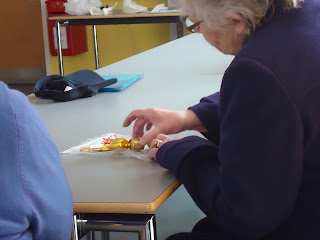This spring the Community History Team at Leeds Museums and Galleries are working with a Peer Support Group, and colleagues from the West Yorkshire Playhouse on the topic of Magic and Mystery. On Tuesday we took a quick look at the ritual practices in Tibet, as Tibetan religious art is famous for its use of human bone – usually the bone of respected priests and abbots, who have shown special spiritual powers during their life-times.
A star item was this mounted skull cup, or Kapala, one of two in the collections (the other was shown in the recent Treasured exhibition at Leeds City Museum, see the detail on the poster). On this cup you can see the human cranium clearly, sitting on the triangular brass stand beneath the encased cover (whose handle knob is now missing). The cover is rather battered but you can still see deity images and key words in Lautsa script round the sides. The cup was found in a Bradford attic in 1962 and taken to Mr S Jackson at Bradford Museum, who gave it to a Mr K Wilson, in Ilkley, to take in to Abbey House Museum. It is amazingly similar to one at the British Museum http://goo.gl/UH2oO.
My
The horned mask has a face made of green leather with red leather lips and a large tongue and gold leather teeth. The nose area seems to be made from a flattened a pierced metal implement, like a masher for vegetables, or a type of hoe for weeding. Large numbers of gilded beads are glued onto the face on the cheeks and forehead. The back of the head is made of red and black woollen fabric, woven and felted, with green wool hair attached. The two horns are of gilded wood and a small carved and gilded skull sits between them. Wire loops threaded with large wooden beads, glass beads and yellow wool tassels and pom-poms rise around the horns. Below the mask are four red velvet flaps which would cover the wearer's shoulder. They are trimmed with curled and coiled foil braid and modern costume jewellery that is clipped on (some of which does feel like marble, and is carved with roses in a Chinese style). The mask also came with a skirt or apron, a drum and a wand. The skirt is very European looking, and we have not been able to understand or translate the symbols on it. The drum is painted with a very European looking dragon, and some Chinese characters, and the wand has a crocodile head which looks as if it belonged to English pantomime.
We are not sure which character the mask represents, or which dance or performance it would have been worn for. The owner of the antique shop who sold the objects to us described the set as a 'Devil Dancer's Outfit'. Here is a link to a video of a cham dance from the Bon (pagan) faith http://goo.gl/Uamsd, if you want to compare this mask set from some modern versions in performance. It’s all very intriguing and if you have ever come across a similar mask set, do let us know.
We also looked at other charm items, from Africa and a small modern charm necklace bought recently in Leeds. Here are some comments from the participants of the session when we asked them if they had their own personal charms.
June always carries a tiny horse’s head of gilt lead in her purse, she has had it for many decades – a gypsy sold it to her when she was 15. A tiny horseshoe was there too, but it dropped out. She also has a silver lucky charm bracelet, which belonged to her mother. 

Trevor used his grandfather’s watch in every exam. It was a good time-keeper, as his grandad was a railway man. His mother had a small coffin with an image of someone laid out inside it. She kept it locked away in a box, and told Trevor that if the image inside ever came out of the coffin a close family member would die.
Maureen has a different charm in each window of her house, a crystal or a rainbow, a chime, all for a bit of feng shui.
By Antonia Lovelace and Sinny Cheung.














